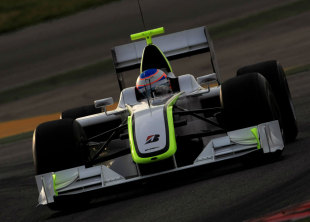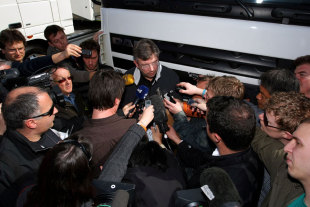- Rewind to ... 2009
When Brawn broke the mould

It was four years ago that Brawn GP turned up at the final group test ahead of the 2009 season and took the paddock by storm. The memory still makes Jenson Button smile.
"We came out of the pits and went quickest by half a second on the first lap ... that was just funny to be honest."
Just a week or so earlier there were still doubts over whether the team would make the grid, let alone be competitive. In early December 2008 Honda put its F1 team up for sale and it took until the following March for a deal to allow a management takeover led by team principal Ross Brawn and CEO Nick Fry to be made official.
During that time BGP001's wind tunnel data had been incredibly positive, but there were no guarantees that would be reflected on track. What's more, with the withdrawal of Honda a new engine supply deal had to be struck with Mercedes and the chassis needed to be redesigned to accommodate the new V8. This was no small feat as the Honda's crankshaft was 6mm lower than the Mercedes' and the whole rear suspension and gearbox assembly had to be raised to accommodate it. There were doubts in the press as to whether the team would have enough time to crowbar the new powerplant in to place, but Brawn GP had snuck a Mercedes engine into its factory before the deal was official in order to give it time to make changes. It was a mighty task given the time period.
But the success of BGP001 was no fluke and its defining feature - its rule-bending double diffuser - can be traced back to 2007. New aerodynamic regulations for 2009 gave teams a chance to start with a blank sheet of paper and Honda and Ross Brawn wanted to make the most of it. When Honda took over Super Aguri it set the team's small aerodynamic group working on the 2009 aero regulations way in advance, and given freedom it soon found the loophole at the rear of the car.
Early in 2008 Honda realised its RA108 was a lost cause and threw all its resources at its 2009 car, unaware that the board in Japan would decide to pull the plug at the end of the year. Midway through 2008 the team's data was showing that the car would have far more downforce than the 2009 regulations had intended and Brawn even sought to address the issue at an overtaking working group meeting. However, some rivals were reluctant to close the loopholes regarding the floor regulations meaning the double diffuser would - by the letter of the rules at least - be legal.
The door was wide open to reap the rewards of the Super Aguri design team's work and Brawn didn't need asking twice. However, when Honda's board in Japan decided to withdraw from F1 at the end of the 2008 season, Brawn had to prioritise survival over performance. So despite confidence within the team there was no guarantee the car would hit the track.
The opening tests in 2009 revealed that Williams and Toyota had developed similar double diffuser concepts, but looking at the times the engineers at Brawn were confident they would have the upper hand if the BGP001 ever hit the track. That day finally came on March 6 when, with the management buyout complete, the new car took to a chilly Club circuit at Silverstone with the team operating out of a tent. The initial feeling was good but there was no way of knowing exactly how it would stack up until the group test on the full Barcelona grand prix circuit on March 9. It didn't disappoint.

The car was 0.6s faster than its rivals on its opening laps and by the final day Button was over a second clear at the top of the timesheets. Inevitably there were still sceptics in the media as it has been known for teams to post laps underweight in order to attract sponsors, and the blank white flanks of the Brawn only served to back that theory up. But for Button there was no doubt that he had a car with the potential to win races.
"Five laps was all I needed to sense it was consistent and reliable, and just incredibly fast," he later said. "Nothing went wrong. Normally when you put a car together for the first time the bodywork doesn't quite fit. It might be too close to the exhaust, which would burn the bodywork and the track rods, or the wishbones would overheat and have to be taped. There are always niggles and snags, but the BGP001 was faultless, which was almost incredible when you think the car was modified and re-built in a matter of weeks to incorporate the Mercedes engine. I've never driven a car like it. That was the moment I knew the 2009 season would be fun."
Fun was perhaps a bit of an understatement. He went on to win six of the first seven races, which set the basis for him to eventually seal the championship. Since then no team has been able to find such a huge advantage so early in the season, especially under such difficult circumstances. There are no signs of it happening this year, quite the opposite in fact with the field looking incredibly tight, but with the overhaul in regulations for 2014 the teams are already working hard to emulate the Brawn fairytale. This time next year will be very interesting indeed.

